Premium
How His Highness the Aga Khan established the 'Nation'
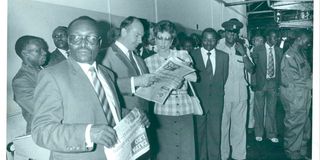
His Highness the Aga Khan acquired a “tiny” Kiswahili newspaper from former District Commissioner Charles Hayes and his business partner, Athea Tebbut, in 1959.
What you need to know:
- His Highness seemed to have been driven by the need to create a platform that articulated the aspirations of the voiceless, the African majority.
- In Birth of a Nation, Gerry Loughran outlines that the Aga Khan established Taifa as a strategic response to the need for media that resonated with the Kenyan population.
It is hard to fathom that the multi-media powerhouse we now know as the Nation Media Group Plc originated from a humble, weekly Kiswahili newspaper called Taifa.
His Highness the Aga Khan, who passed away on Tuesday at the age of 88, had taken a break from his studies in the US in 1957 to visit East Africa as he prepared to assume the mantle of Imam of the Ismaili Muslims following the death of his grandfather. At just 20 years old, he sensed the gathering storm that would change the African political landscape.
As Gerry Loughran notes in his book, The Birth of a Nation: The story of a newspaper in Kenya, His Highness “was already looking beyond the ceremonial and pondering the future in East Africa. Independence, he believed, was inevitable.”
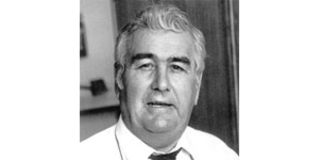
Nation columnist Gerard “Gerry” Loughran. He died on Wednesday in a hospital in the United Kingdom.
Gerry, a pioneering editor in the Nation stable, further notes that during his enthronement tour of East Africa, the Aga Khan took note of a comment from his press advisor, Michael Curtis, regarding the “abysmal quality of newspapers in Kenya and Uganda, old British Empire places where the papers were quite simply the mouthpieces of the colonial government.”
That seemed to have planted a seed in his mind, which would germinate incredibly fast.
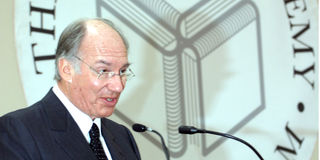
Indian Spiritual Leader, His Highness The Aga Khan speaks during the laying of a foundation stone at the Aga Khan Acadamy in Tanzania's capital Dar es Salaam on March 17, 2005.
Upon completing his studies, he announced his desire to start a newspaper, and, in quick succession, acquired a “tiny” Kiswahili newspaper from former District Commissioner Charles Hayes and his business partner, Athea Tebbut, in 1959.
He swiftly transformed the paper into a daily, with Sunday Nation following in March 1960. The Daily Nation debuted in October of the same year.
A new voice for Kenyans was established.
His Highness seemed to have been driven by the need to create a platform that articulated the aspirations of the voiceless, the African majority.

The Aga Khan, spiritual leader of Ismaili Muslims, looks on during a speaking event at Massey Hall in Toronto, February 28, 2014.
Taifa, operating under the aegis of East African Newspapers (EA), Nation Series, hit the newsstands on April 28, 1959. Its first issue sold 15,000 copies. Its daily counterpart, Habari za Leo Taifa, launched on January 15, 1960, became the first Kiswahili daily in East Africa.
The paper’s performance indicated a void that was waiting to be filled. Records show that the initial press run sold 14,000 copies, followed by 10,000 the next day. By December of that year, sales had reached 37,000, and the paper maintained this successful trajectory, peaking at 60,000 copies.
Information for all in Kenya
In Birth of a Nation, Gerry Loughran outlines that the Aga Khan established Taifa as a strategic response to the need for media that resonated with the Kenyan population.
The Aga Khan recognised that Kiswahili was not only widely spoken in Kenya, but also a vital part of the country’s cultural identity. He believed that a well-written and organised publication in Kiswahili would engage a broader audience and make information more accessible.
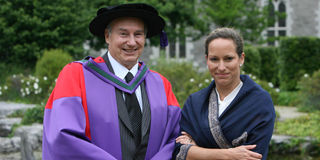
His Highness the Aga Khan (left) with his daughter Princess Zahra (right) before he was honoured by the National University of Ireland, Maynooth for his work against poverty and in promoting religious understanding.
His broader idea was to empower the African population by providing news and information in a language they were at home with, thus fostering an informed citizenry capable of participating in the democratic process as the clamour for independence from colonial rule intensified.
The publication would cater to diverse communities, neatly aligning with his desire to promote unity and inclusivity during a time of political change and social upheaval.
Information for all in Africa
In later years, as subsequent changes in the Nation stable confirmed, His Highness had a larger vision for media in Africa. He envisaged media as a catalyst for social and economic development across the continent and believed that responsible journalism could address societal issues and support community growth.
This vision included the idea that media should serve as a watchdog for democracy, advocating transparency and accountability in governance. He considered quality and integrity non-negotiable principles in pursuing this agenda.
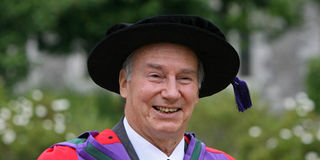
His Highness the Aga Khan who was honoured by the National University of Ireland, Maynooth, for his work against poverty and in promoting religious understanding.
Annual business performance reviews at his Aiglemont estate on the outskirts of Paris served as key interactions to evaluate the group's performance, identify fault lines that could undermine the business, and emphasise the importance of high journalistic standards and ethical reporting.
“Speak truth to power,” he would remind us, “but don’t chastise for the sake of it,” while committing to defend our editorial independence amid mounting government pressure to tame “misguided enthusiasm” in serving the public interest.
The Aga Khan aimed to create platforms that would amplify diverse voices and perspectives, particularly those of marginalised communities across the continent.
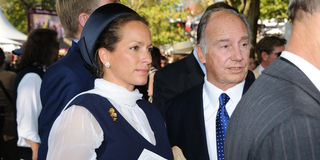
His Highness the Aga Khan and Zahra Aga Khan attending the 90th edition of the Qatar Arc de Triomphe prize at the Longchamp racecourse on October 2, 2011 in Paris, France.
Overall, the establishment of Taifa was a pivotal moment in his broader vision to nurture a vibrant, responsible media landscape that could contribute to societal growth.
In later years, as Taifa ’s fortunes declined, the management began considering its discontinuation. However, The Aga Khan would hear none of it.
This demonstrated how fully invested he was, not just because it remained the sole daily Kiswahili newspaper in Kenya after the collapse of the much older Baraza newspaper in the East African Standard’s stable, but also because it served as a significant springboard for his personal investment in East Africa, particularly in the media.
Wangethi Mwangi is a former Editorial Director of the Nation Media Group PLC


